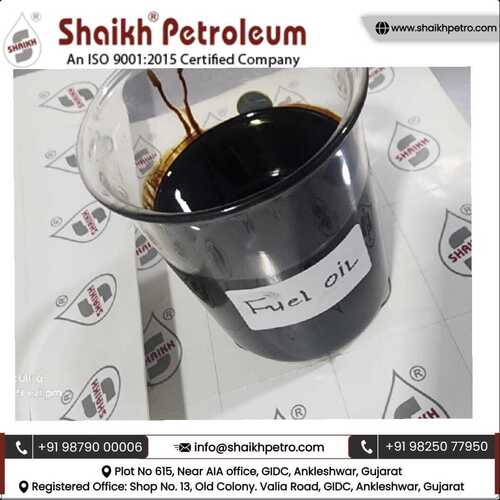Tyre Pyrolysis Fuel Oil
Product Details:
- Use Fuel Oil is a residual fuel (motor spirit / gasoline, high speed diesel and kerosene are distillate fuels). It is a dark, viscous liquid at room temperature. It is a complex mix of hydrocarbons with carbon atoms ranging mainly from 20 to 55. It is produced by blending residues from various refinery processing units and diluting with middle distillates.
- Type Fuel Oil And Bio Furnace
- Density 0.92 to 0.93 Kilogram per cubic meter (kg/m3)
- Color BLACK
- Pack Type IN BERREL
- Click to View more
Tyre Pyrolysis Fuel Oil Price And Quantity
- 1000 Kilograms
- 45.00 INR/Kilograms
Tyre Pyrolysis Fuel Oil Product Specifications
- BLACK
- IN BERREL
- Fuel Oil And Bio Furnace
- 0.92 to 0.93 Kilogram per cubic meter (kg/m3)
- Fuel Oil is a residual fuel (motor spirit / gasoline, high speed diesel and kerosene are distillate fuels). It is a dark, viscous liquid at room temperature. It is a complex mix of hydrocarbons with carbon atoms ranging mainly from 20 to 55. It is produced by blending residues from various refinery processing units and diluting with middle distillates.
Tyre Pyrolysis Fuel Oil Trade Information
- Cash on Delivery (COD) Cash in Advance (CID) Cheque Cash Advance (CA)
- 100 Kilograms Per Day
- 48 Hours
- Yes
- Free samples available with shipping and taxes paid by the buyer
- All India
- ISO 9001:2008 Certified
Product Description
Light Diesel Oil falls under class C category fuel having flash point above 66OC It is a blend of distillate components and a small amount of residual components It is marketed under BIS 14602000 specification for Diesel fuels We deals in Brand like Castrol Hindustan Petroleum HP Indian Oil Corporation IOC Gulf Veedol
LDO is used in lower RPM engines It is used in Lift irrigation pump sets DG Sets and as a fuel in certain boilers and furnaces
SAFETY INFORMATION
Reactivity Data Chemically stable and incompatible with strong oxidizers Does not React vigorously with common materials but may react with oxidizing agents
Health Hazard Data Routes of entry may be through inhalation ingestion skin eye
EFFECTS OF EXPOSURE SYMPTOMS
Inhalation causes dizziness and headache
Ingestion may lead to nausea vomiting irritation of mouth and gastrointestinal effects likely Potentially fatal chemical pneumonitis
On Skin and eye contact irritation will remove natural fats from skin Prolonged or repeated contact should be avoided Otherwise skin chapping or cracking or possible contact of dermatitis may result Dry skin erythema oil acne and oil folliculitis and warty growth may occur which may become skin cancer subsequently on excessive repeated exposure
EMERGENCY TREATMENT
Inhalation Remove victim to fresh air Give artificial respiration if necessary If unconscious but breathing place in recovery Unconscious position and give external cardiac massage if necessary
Ingestion Do not induce vomiting Remove contaminated clothing Wash all affected skin thoroughly with soap and water
Eyes Irrigate eyes with copious amounts of water Administration of medical paraffin may reduce absorption through digestive tract
Gastric lavage should be done only after endo tracheal intubation in view of respiration which may cause serious chemical pnemonitis for which antibiotic therapy may be indicated
IS 15921982
Requirements for Light Diesel Oils Clause 42
No Characteristic Requirement for LDO Method Of Test
1 Acidity Inorganic
P2
2 Acidity total mg of KOHG Max
P2
3 Ash percent by mass Max 002 P4
4 Carbon residue Ramsbottom on 10 percent residue percent by mass Max 15 P8
5 Cetane number Min
P9
6 Pour point Max 12oC for winter and 21oC for summer P10
7 Copper strip corrosion for 3 h at 100oC Not worse than No 2 P15
8 Distillation 90 percent volume recovery atoC Max
P18
9 Flash point
Abel o C Min
P20
PenskyMartens oC Min 66 P21
10 Kinematic viscosity cSt at 40o C 25 to 157 P25
11 Sediments percent by mass Max 010 P30
12 Density at 15oC kgm2
P32
13 Total sulphur percent by mass Max 18 P33
14 Water content percent by volume Max 025 P40
15 Cold Filter Plugging Point CFPP Max
P110






